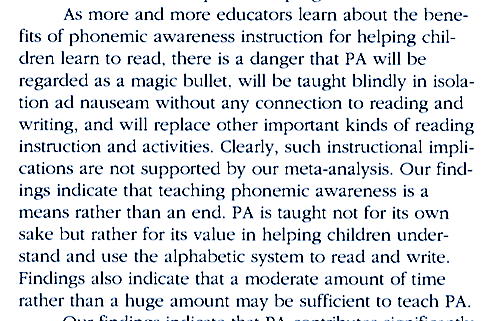The Surprising Recommendations about Teaching PA

It’s a great thing that our understanding of the role of phonological and phonemic awareness has increased in recent times. This shift in awareness means that the largest number of children possible have the active ingredients necessary to learn to read well. Phonological and phonemic awareness is divided into two sections:
- Phonological sensitivity – the awareness of language units larger than phonemes. This includes syllables, rhyming, onsets and rimes, phrases and words.
- Phonemic awareness – the awareness of and ability to manipulate individual phonemes (speech sounds) in words.
The above is pretty common knowledge, but when it comes to actually teaching it and facilitating development in the classroom, what does the research say? As a teacher, it’s really quite difficult to access and understand all those research papers and so it’s a good thing that we can draw upon the work of academics and the researchers themselves through the books and articles they release to help us understanding what it all means.
Let’s start with the National Reading Panel findings. The National Reading Panel was convened by the United States Congress to investigate the research around reading instruction. The report contains 6 chapters, the first 4 relate to the 5 key areas of reading instruction – phonological and phonemic awareness, phonics, vocabulary, fluency and comprehension. It’s easy to be overwhelmed when approaching this mammoth 449 page document, but just focus on one section at a time and you’ll be fine. Each section talking about the big 5 is divided into further sections. To access the recommendations and most practical parts for your own teaching, look for the executive summary in each section. Of course, you can read the full report for each section too, but if you haven’t taken a course in statistics or research methodology, you might find it a bit bamboozling!

So, what does the National Reading Panel Executive Summary recommend about PA? The answers might surprise you!
- Instruction in one or two skills at a time is more effective than teaching a large range of skills at a time.
- Blending and segmenting instruction yielded the greatest results.
- Using graphemes in instruction was more effective than oral only instruction for both reading and spelling development.
- Teaching between 5-18 hours of PA instruction (in total) was more effective than programs that lasted for long than 20 hours.
- The students who benefit the most from explicit PA instruction were those at risk of reading difficulty. That is, they made the largest gains, not that it’s not beneficial for all students.
- Explicit, whole class instruction was beneficial for all students in the foundation year, but that in year 1 and 2 should only be delivered to those who are at risk and need it. Beyond the initial instruction, teachers should utilise data to target teaching appropriately.
- Programs taught in small groups were more effective (although the report also recommended further research be done on this and there are subsequent studies showing that it can be very effectively taught whole class).
- It is important to help children learn to apply blending and segmenting in word level reading and spelling. The development of phonemic awareness is not an end all by itself, but is important in its role in reading and spelling overall.
The following is a clip from this article summarising the panel’s findings.

It’s understandable that you might be thinking something like, ‘Well sure. Maybe that’s what the Reading Panel said, but it’s not what I believe or not what others might say.’ (It’s a natural reaction when we are challenged to want to discredit or reject the idea that made us uncomfortable) But another way to think of it is to embrace the challenge as a gift of perspective and spend a bit of time thinking about whether there is something for us to learn.

When it comes to PA, let’s examine some of the other sources of information on this (which is not an exhaustive list by any means!)
Louise Moats – Speech to Print (2020)
Pg. 81 – “A few brief activities – about 5-10 minutes – a day for 12 to 20 weeks are all that most young students need to improve speech awareness”.
Pg. 82 – “Use letters and graphemes to represent sounds as soon as young students have a clear concept of what they represent. Letters reinforce phoneme awareness and support it once students have learned to attend to sounds.”
Mark Seidenberg – Language at the Speed of Sight (2017)
Pg 121 – “It is also important to appreciate the extent to which “phonemic awareness depends on spelling… ‘Phonemic Awareness’ is not just about sounds; it’s also about spelling.”
David Kilpatrick – Essentials of Assessing, Preventing, and Overcoming Reading Difficulties (2015)
Pg 262 – “…phonemic awareness training is most effective when it is not taught as an isolated skill. Phonemic awareness instruction has its greatest impact when it is integrated at some point with the learning of letters and written words.”
Where does this leave us?
You might be feeling a little troubled or challenged by what I’ve just shared. After all, many schools have invested in oral only programs that last for 3 or 4 years and have now become a core, significant part of their teaching. I’m going to share something with you. I bought such a program for my own school too! Does that make me stupid? No, of course not. I made the best decisions I could with the information I had to hand at the time. Did that program help the students in our school have a greater awareness of PA? Yes it did. Was it the most direct, most efficient path to reading and spelling? Not really. Now I know that there’s a better way; a way to get even more bang for the buck, I do things differently.
So, if could fire up a flux capacitor, pop into a time machine, go back a few years and have a chat with my former self, what would I say?

- Don’t throw out the oral PA program, but don’t make it a major part of the literacy block. 5-10 minutes gets the job done. Instead of taking up ‘literacy block’ time with it, use it as a 5-minute activity before lunch or home time instead of watching Bluey.
- Be more specific with the team about not needing to provide ongoing, whole class PA instruction beyond the point its needed (in year 1 and 2).
- When using that oral PA program, just focus on the two skills you know that children need right now. Teach those skills and then move on.
- Once the children have the skill/awareness, stop teaching it and spend that precious time on other things.
- Good job on included blending and segmenting (word level reading and spelling) in every phonics lesson. Gold star to you!
- Keep up the skill monitoring with the PA skills – it’s really important to work from the data so that you aren’t wasting instructional time on things that are too easy or too hard.
- Look to the research first instead of buying into a resource because it makes sense to you.
If I went back in time more than a few years I’d tell myself,
- Don’t wait until the kids have all the oral skills before introducing graphemes (yep, I used to think this was a good idea)
- Use the transitions between classroom activities as teachable moments to raise awareness of things like syllables (have kids chop their names as you send them off to wash their hands).
- Stop wasting ink on PA worksheets and booklets for individual work. Students get way more out of a whole class lesson with you!
If we are going to be evidence informed, we actually have to invite the evidence to inform our practice. Sure, there are times when there hasn’t been enough research conducted to be able to rely on evidence completely, and we will have to draw some conclusions based on the knowledge we have at the time, but when it comes to PA, we DO have decent findings to guide us. Living with the discomfort of those findings and what they mean for our practice isn’t easy. I ask you to take a deep breath and recognise that learning more and adjusting practice doesn’t mean you are a bad teacher. It means you are a good one.

 Jocelyn Seamer Education
Jocelyn Seamer Education
5 comments
Hi Jocelyn,
Wow! Thanks for that. At the start of this year, my Year 1s had poor PA and it was a road block to reading and writing. I wondered if it was the COVID interruption that made it so noticeable at the start of 2021.
I invested in Kilpatrick and Heggerty activities and achieved some quite speedy results in about 15 weeks.
Our PA now is incorporated into our focus graphemes, but I no longer feel the need to follow a specific program. Our intervention group is following parts of the Heggerty program, but we are being quite focused on which PA aspects will support the small group lesson focus. I'm so glad this article reinforces that the research is backing our "gut feeling".
Another great read and thank you again.
What grades are your Year 1 and Year 2? Would that be equivalent to Kindergarten and 1st grade in U.S.? And, with adding in the graphemes to the activities, how soon would you do that as part of the PA activity? Our teachers mostly do Heggerty whole group and orally, and they do Kilpatrick's one minute drills in small group to try to move the students higher up in the levels. Should that be happening in all those small group sessions to help the students see why they are doing those drills and how it can help them with decoding and encoding?
Thank you!
hi Jocelyn,
I love all of your teaching tips--look forward to receiving them in my email inbox every few days. This entry about PA was so helpful to me as validation of what I've noticed with my small-group reading students. I love the approach of connecting PA activities to the sound/spellings that you're working on with your students. That makes intuitive sense to me so it's nice to hear that research supports this practice. And also reassuring to hear that doing too much PA all at once is not recommended. I have wondered for a while about this--at one point I was trying to follow a Heggerty-like approach with small groups, but there's no way I could fit in all of the activities in the time I had with the students, and I also felt like it could be overwhelming/confusing for them to be doing too many PA drills all back to back. Sorry for all the rambling!
stephanie
Thanks for this great article! Our school invested in Heggerty last year and we have definitely seen an improvement in our students’ PA. However, I’m questioning some components of it lately. Is it necessary to do the syllable segmentation, compound word and onset-rime sections, etc. ? It seems like it confuses my students. Would it be ok to jump directly to phoneme segmentation and blending? That’s what I really want them to be able to do anyway! I can also see the value in doing the onset fluency, medial and ending sound activities. I started questioning the value in all of this when I was assessing a student on Dibels PSF. On every word, she gave the onset-rime instead of segmenting each word into phonemes. I would love to have some guidance on this! Any thoughts? Thanks so much!
Hi Debbie. It sounds like you know where your students are and where you want them to go. I think that your plan to build foundations and then focus on the most important bits is very sound. :) All the best, Jocelyn
Leave a comment